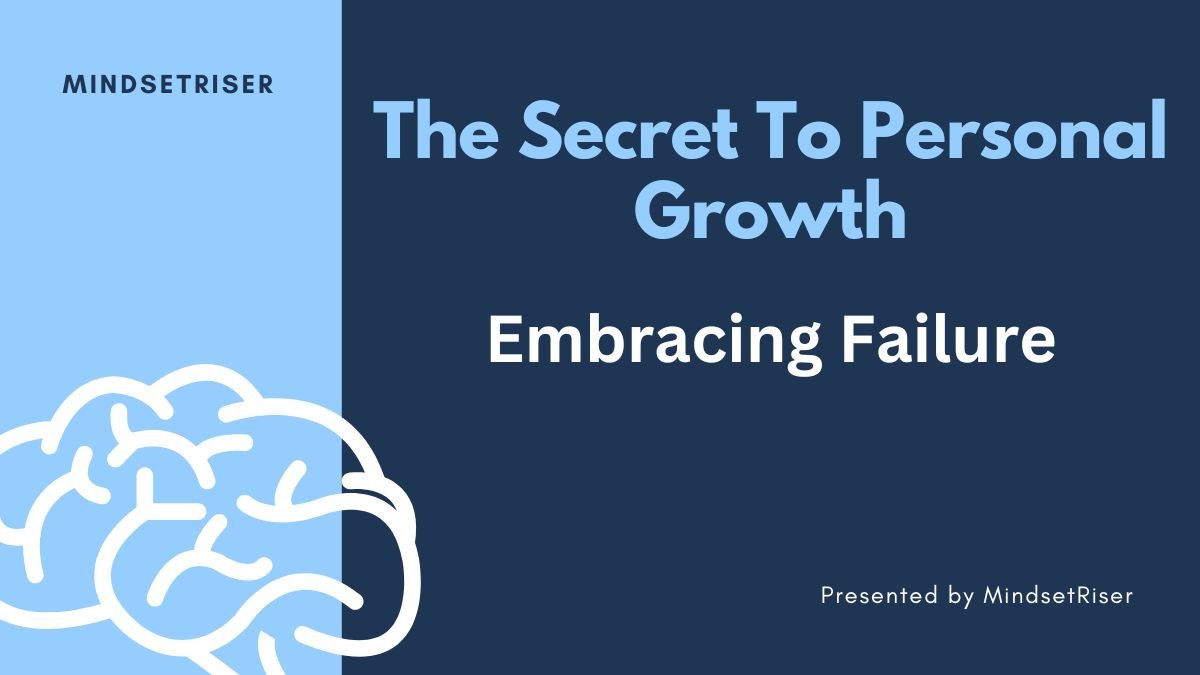Why Embracing Failure is the Secret to Personal Growth
Failure is often seen as something negative, something to be avoided at all costs. In reality, failure is a powerful teacher and an essential part of personal growth. While we might instinctively shy away from failure, it’s the moments when we fall short that often shape us the most.
This article will explore:
✅ Why failure is essential for growth
✅ How to embrace failure without fear
✅ How to use failure as a stepping stone to success
Why Failure is Essential for Personal Growth
Have you ever heard someone say, “Failure is not an option”? The truth is, failure is not only an option—it’s often the best option. Growth doesn’t happen in the comfort zone; it happens when we challenge ourselves, face setbacks, and learn from them. Here’s why embracing failure is a crucial part of your journey:
1. Failure Teaches Resilience
Each time you fail, you develop emotional resilience—the ability to bounce back stronger from adversity. Failure forces you to adapt and find new ways to overcome challenges. Without failure, you wouldn’t build the mental toughness that’s essential for facing future obstacles.
Think about the most successful people in history. They didn’t get there without failure. Instead, they learned from their mistakes and kept going. Resilience is a muscle, and failure is one of the best workouts for it.
2. Failure Helps You Learn and Improve
Failure isn’t the end of the road, but a necessary part of the process. Each failure provides valuable insights into what went wrong, where you can improve, and what you can do differently next time. Instead of feeling defeated, use failure as an opportunity to adjust your approach.
Without failure, you’d never have the chance to refine your skills or discover new strategies for success. Every mistake is a lesson that can bring you one step closer to your goals.
3. Failure Builds Confidence
It might sound counterintuitive, but failing and continuing to try anyway actually builds confidence. When you face failure head-on and keep going, you prove to yourself that you’re capable of handling challenges. Each failure shows that you are willing to take risks, try new things, and keep moving forward despite setbacks.
The more you embrace failure, the more confident you become in your ability to navigate life’s uncertainties.
4. Failure Breaks Fear’s Grip
Often, fear of failure is the biggest thing that holds us back. When we fear failure, we hesitate to take action, avoiding opportunities that could lead to growth. However, once you start embracing failure, you realize that it’s not as scary as you thought.
The fear of failure can paralyze us, but failure itself often teaches us that it’s not the end of the world. When you stop fearing failure, you unlock the ability to take risks and pursue what truly matters to you.
How to Embrace Failure Without Fear
As much as we talk about the importance of failure for growth, facing failure without fear can still be daunting. So how can we shift our mindset and accept failure as a natural part of the process? Let’s break down some practical steps you can take to embrace failure and move forward with confidence:
1. Reframe Your Perspective on Failure
One of the biggest hurdles we face is the belief that failure equals defeat. Instead, try to see failure as a necessary step toward success. Reframing failure as a learning opportunity—rather than something to be ashamed of—helps shift your mindset and reduces fear.
How to reframe failure:
- Instead of thinking, “I failed,” think, “I learned something valuable.”
- Remember, failure isn’t permanent; it’s just a part of the journey.
- Celebrate the lessons you’ve gained from each failure.
2. Develop a Growth Mindset
A growth mindset is the belief that your abilities and intelligence can be developed through dedication and hard work. This perspective encourages you to see failure as a stepping stone, not a sign of incompetence.
When you adopt a growth mindset, you understand that failure doesn’t define you. It’s just a part of the process. Rather than feeling discouraged, you’ll feel empowered to learn, try again, and grow from each experience.
3. Separate Yourself from Your Failures
One of the reasons failure can feel so personal is because we tend to identify ourselves with our mistakes. Remember, failing at something doesn’t mean you are a failure. Your worth is not tied to your mistakes.
How to separate yourself from failure:
- When you fail, acknowledge that you made a mistake or misjudgment, but that doesn’t make you a failure as a person.
- Focus on what you can do differently next time, rather than beating yourself up.
- Remind yourself that everyone fails—it’s part of being human.
4. Accept That It’s Part of the Process
The path to success is rarely a straight line. Failure is inevitable, but it doesn’t mean the journey is over. In fact, failure is an integral part of your growth, helping you refine your strategies and increase your chances of success in the future.
How to accept failure as part of the process:
- Trust that failure is not a dead end—it’s just a temporary setback.
- Understand that every successful person has failed at some point.
- Keep going, even when failure happens. The key is to keep learning and adapting.
5. Cultivate Self-Compassion
When failure strikes, it’s easy to be hard on yourself. Self-compassion allows you to treat yourself with kindness during tough moments, rather than getting caught in a cycle of self-criticism. The more compassionate you are with yourself, the easier it becomes to embrace failure.
How to practice self-compassion:
- Talk to yourself like you would a friend who’s struggling.
- Remember that everyone fails and that you are worthy of love and encouragement, even when you make mistakes.
- Forgive yourself for failures and give yourself the space to move forward without guilt.
How to Use Failure as a Stepping Stone to Success
The key to turning failure into a stepping stone is shifting your perspective. Rather than viewing failure as a roadblock, see it as a launchpad for greater success. Here’s how you can use failure to fuel your future achievements:
1. Analyze Your Failures Constructively
After experiencing failure, take the time to reflect on what went wrong and identify areas for improvement. This is not about blaming yourself but about gathering data that will help you do better next time.
How to analyze failure constructively:
- Break down the situation: What were the circumstances? What was within your control?
- Identify patterns or mistakes that you can learn from.
- Create an action plan for how you’ll approach similar challenges in the future.
By analyzing your failures, you turn each one into a valuable lesson that increases your chances of success.
2. Adjust Your Approach Based on Lessons Learned
Once you’ve identified the lessons from your failures, it’s time to adjust your strategy. Success isn’t just about trying harder—it’s about trying smarter.
How to adjust your approach:
- Revise your goals if necessary. Are they realistic? Are you setting yourself up for success?
- Test new strategies or approaches based on what you’ve learned.
- Stay flexible—sometimes, the first way isn’t the best way, and failure shows you where to improve.
Each failure is an opportunity to refine your approach and move closer to your goals.
3. Use Failure to Build Stronger Connections
Failure can be an excellent way to build stronger relationships. When you open up about your struggles and setbacks, you create opportunities for others to offer their support, advice, and encouragement. Vulnerability strengthens bonds, and sharing your failures can help you feel more connected to others.
How to use failure to strengthen connections:
- Talk openly with mentors, friends, or colleagues about what you’ve learned from your failures.
- Use your experiences to offer advice to others who may be going through similar challenges.
- Find a support group or community that helps you stay motivated and holds you accountable.
4. Keep the Big Picture in Mind
It’s easy to get lost in the details of a single failure, but the most successful people keep their eyes on the bigger picture. Failure is a single moment in time, but your journey to success is ongoing.
How to maintain the big picture:
- Remember your long-term goals and why they matter to you.
- Don’t let temporary setbacks define your path—every success story is built on multiple failures.
- Trust that each failure brings you closer to your ultimate success.
When you maintain focus on the larger picture, you’ll be able to view failure as part of the process, not the end of the road.
5. Stay Persistent and Keep Moving Forward
Perhaps the most important lesson failure teaches is the importance of persistence. Success rarely happens on the first try, and failure is simply a sign that you need to try again, with new insights and strategies.
How to stay persistent:
- Setbacks are normal, but don’t let them stop you. Keep putting in the effort.
- Celebrate small victories along the way, as they’ll keep you motivated.
- Keep your long-term vision in mind and trust that persistence will lead to growth and success.
Conclusion: Embrace Failure, Embrace Growth
Failure is not something to be feared or avoided. It’s an integral part of the growth process and a powerful teacher. By embracing failure, reflecting on what it can teach you, and using it to adjust your approach, you’ll unlock your true potential.
The next time you fail, remember:
- Failure builds resilience, teaches valuable lessons, and fosters growth.
- Failure is not personal—it’s simply part of the journey.
- The most successful people are those who embrace failure, learn from it, and keep going.
So, don’t fear failure. Embrace it, learn from it, and use it as a stepping stone on your way to greater success.

